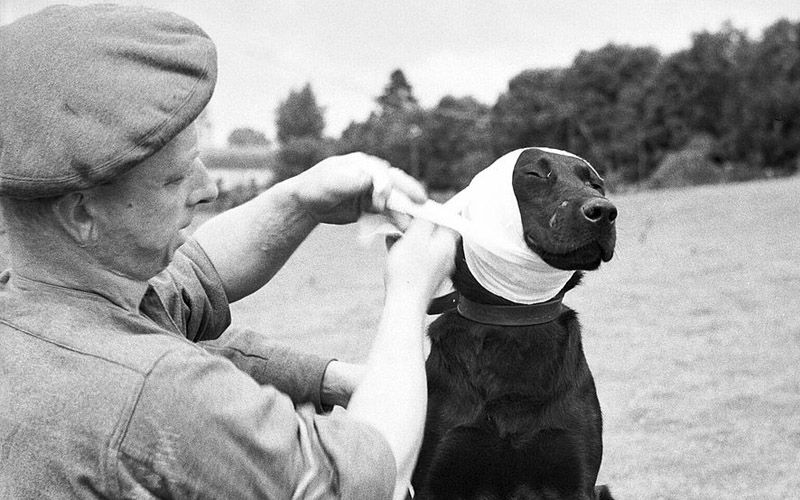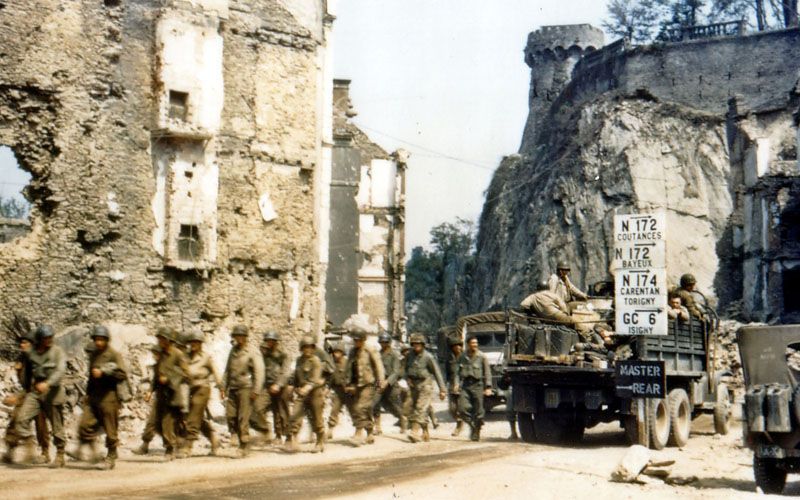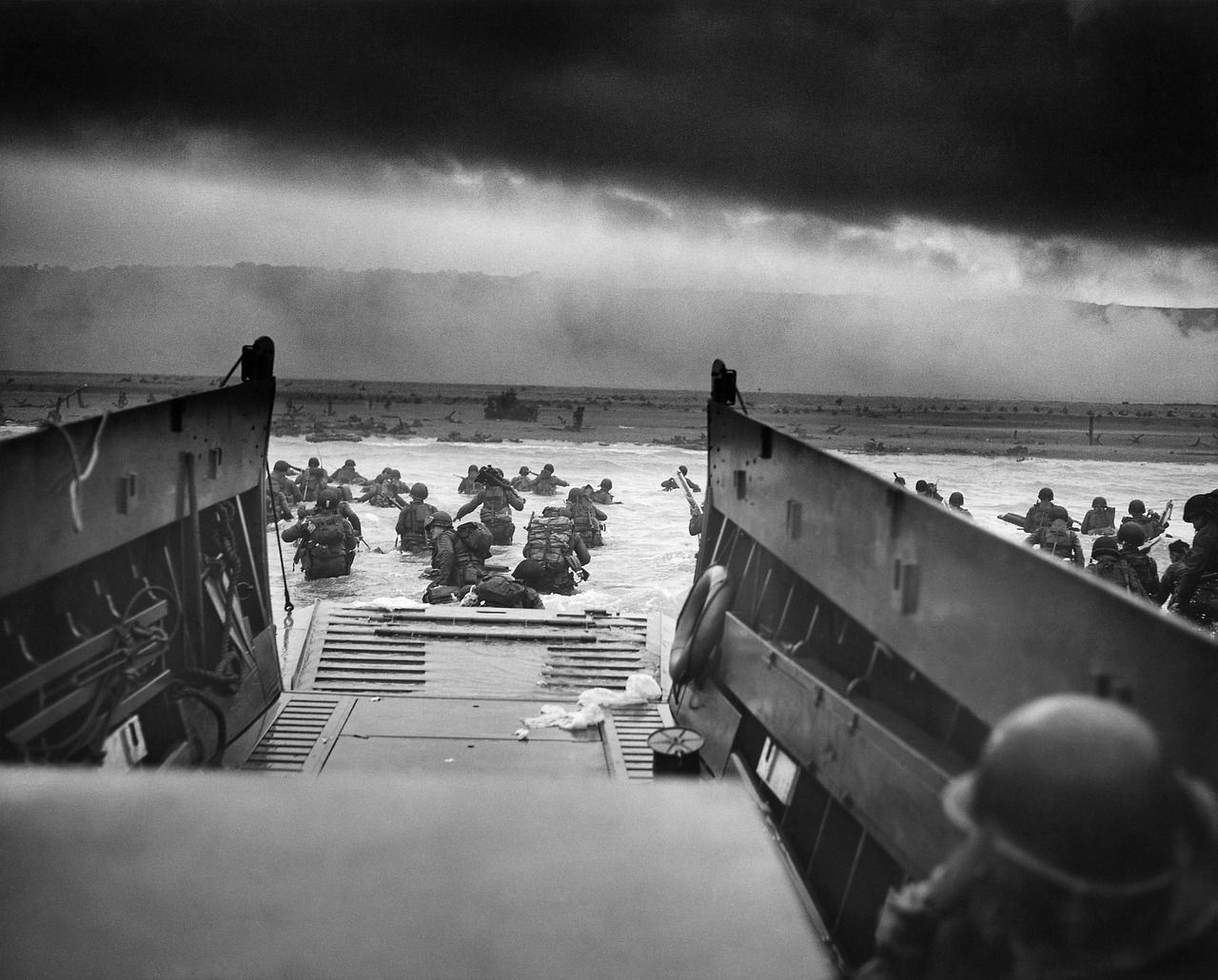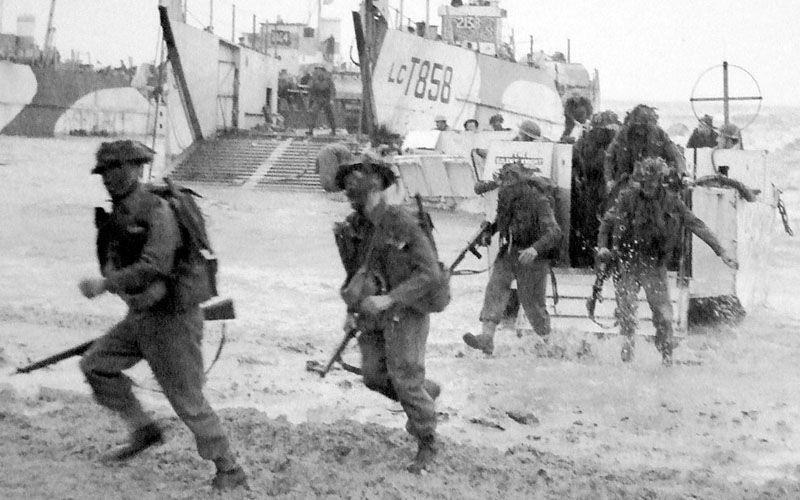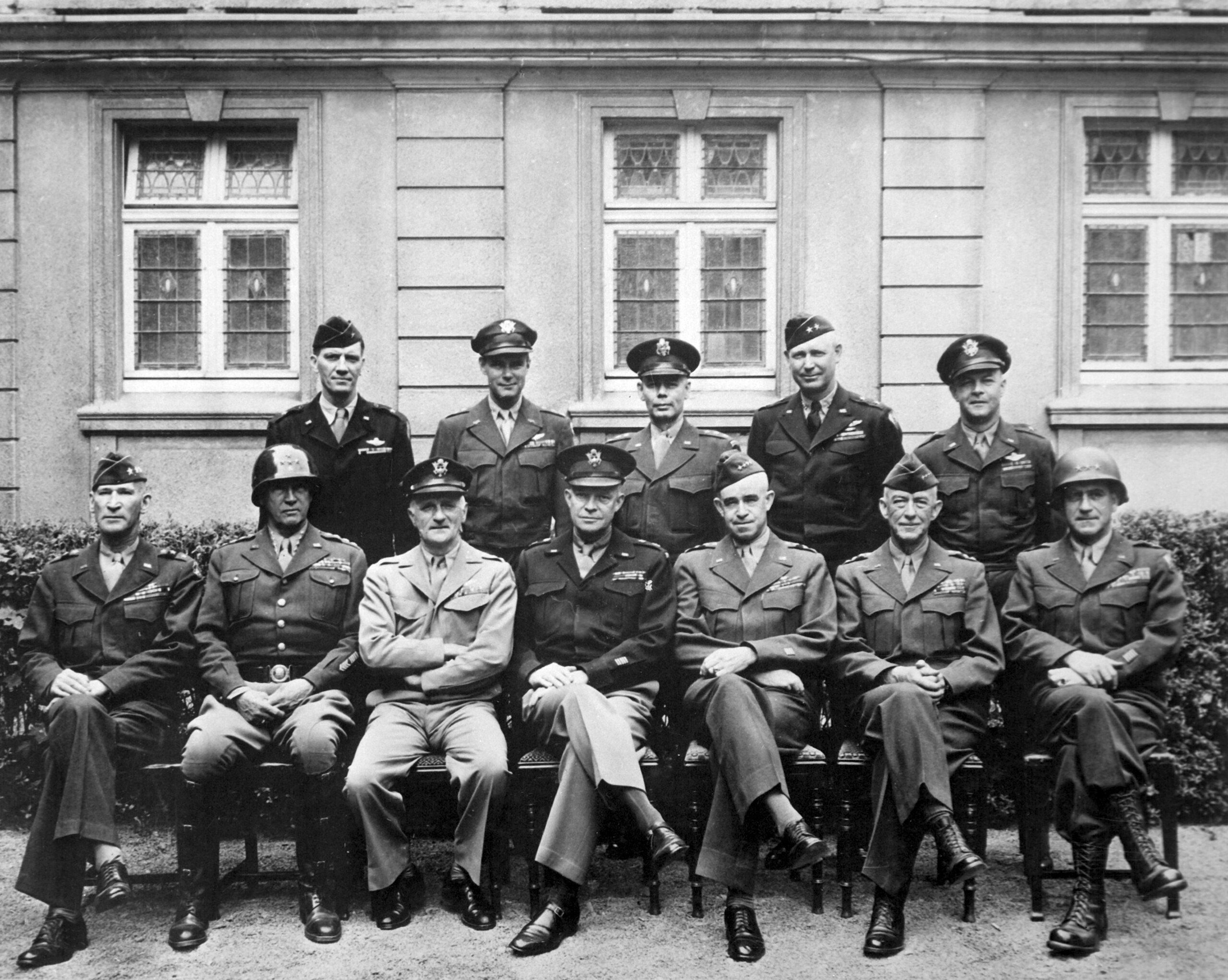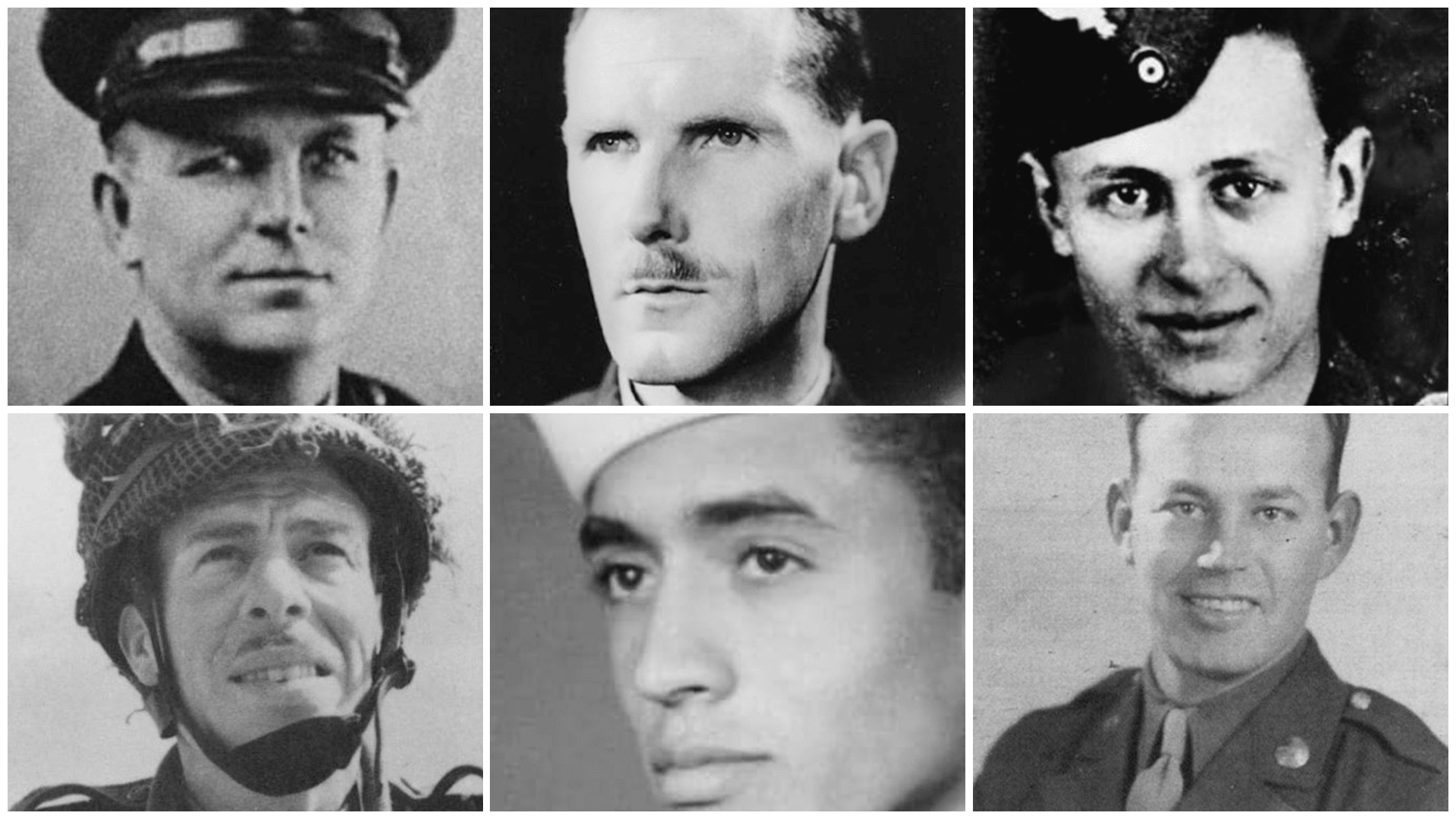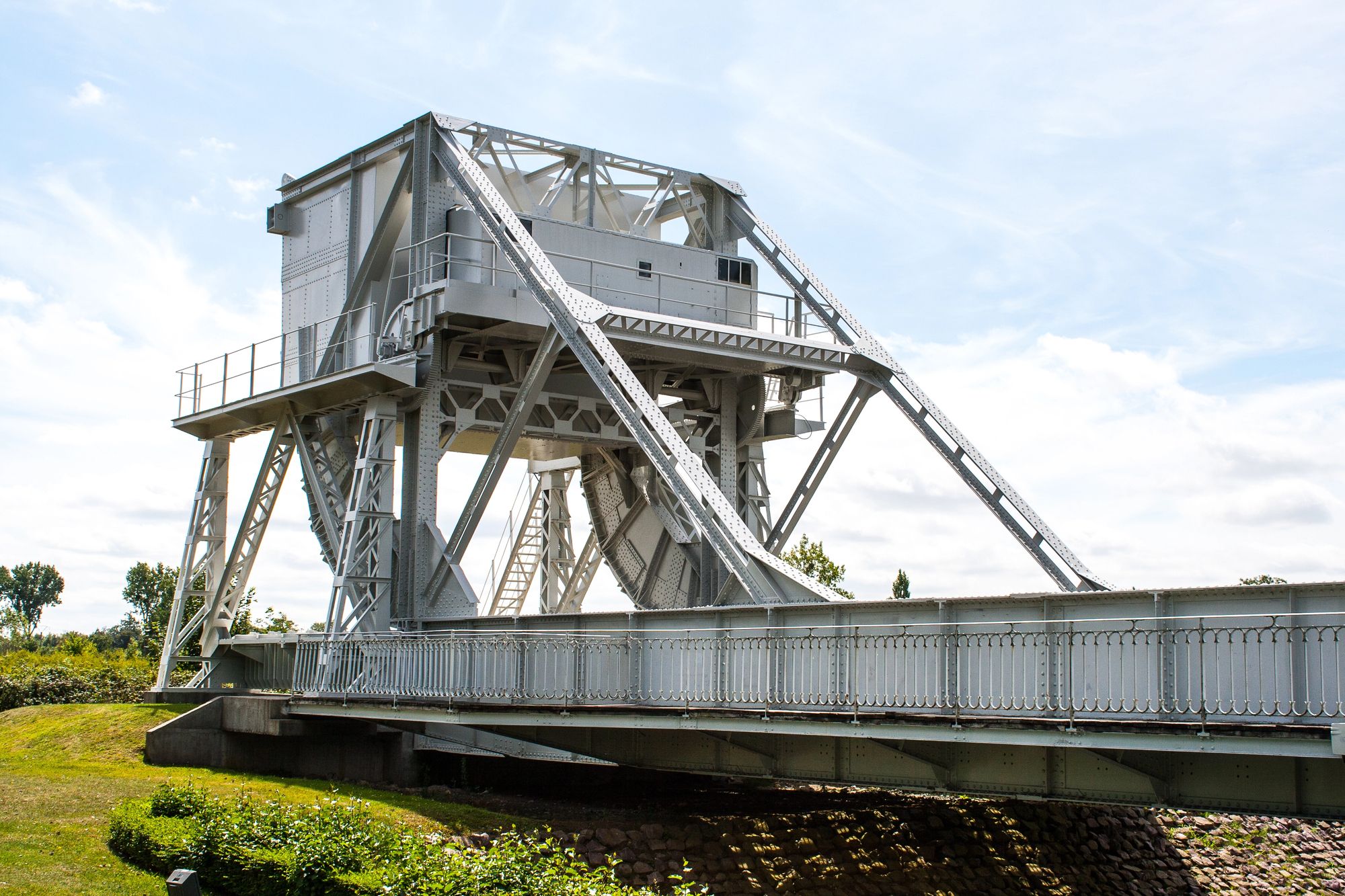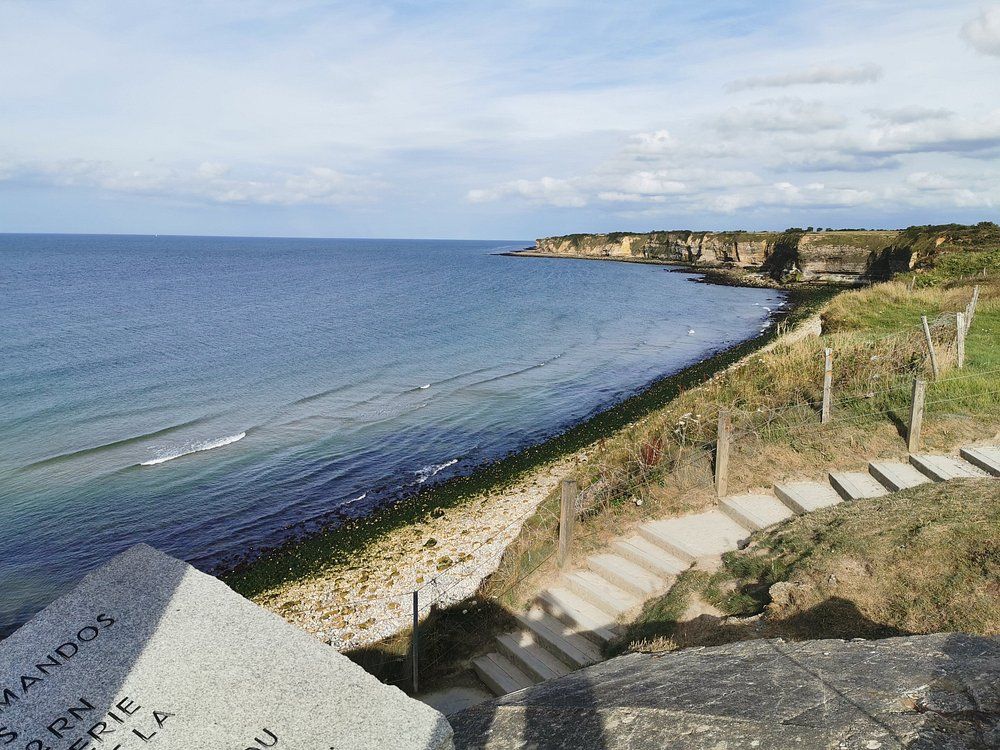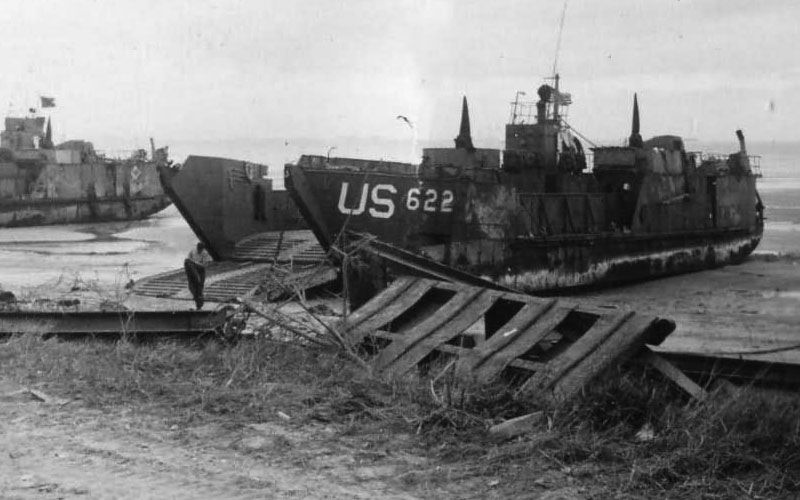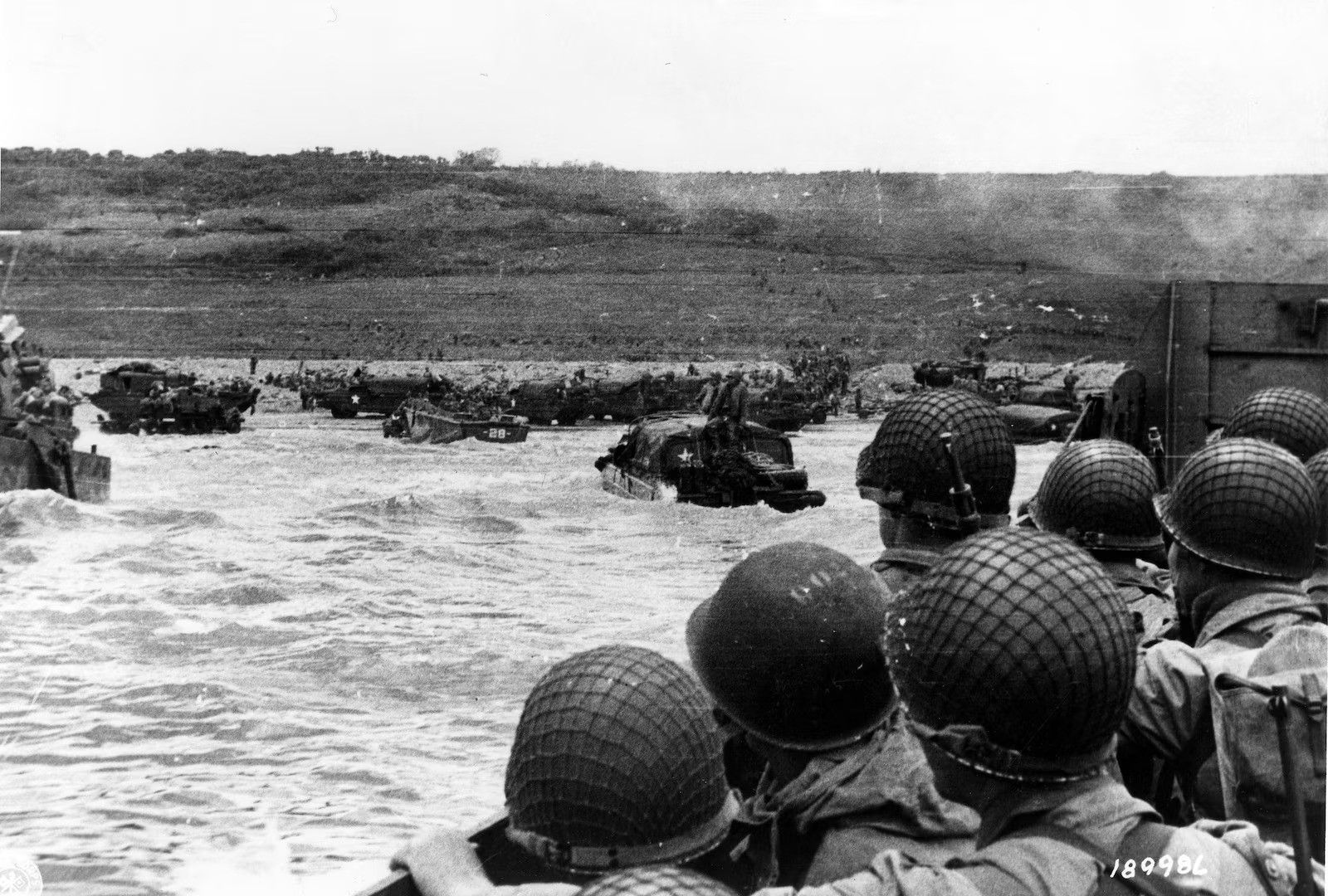In London W1 a memorial stands in honour of animals that served alongside British, Commonwealth and Allied forces during different 20th Century conflicts. Constructed from Portland Stone and cast bronze, the memorial sits 58ft wide and 55ft deep. Engraved upon the wall are the ghostly silhouettes representing some of the different breeds of animal to have served alongside the military.
In 1943 Maria Dickin, founder of the People’s Dispensary for Sick Animals (PDSA), established the Dickin Medal. The bronze medal, decorated with a laurel wreath, honours the work of animals during wartime. It is inscribed “For Gallantry” and “We Also Serve”. Between 1943 and 1949 the medal was awarded 54 times. The medal was re-established in 2000 and has since been awarded more than a dozen times. The medal is awarded to animals which have displayed “Conspicuous gallantry or devotion to duty” whilst serving or being associated with any branch of the Armed Forces or Civil Defence Units. During the Second World War, the Dickin Medal was awarded to 32 pigeons, 29 dogs, 4 horses and a cat. Five medals were awarded to animals during the Normandy Campaign, all of which were for pigeons. Below is a little bit about the brave birds:
Gustav, was awarded the medal on 1st September 1944. He delivered the first message from the Normandy Beaches on 6th June. Gustav flew a distance of some 125 miles.
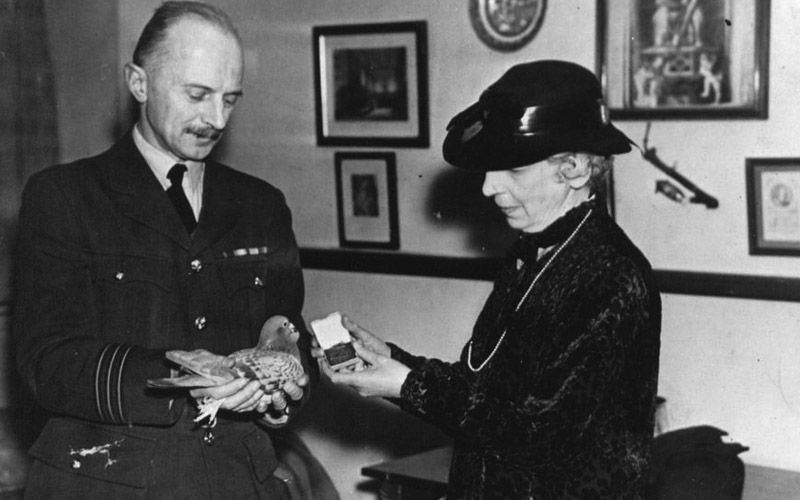
Paddy, is said to have held the best recorded time with a message from the Normandy Beaches in June 1944. This Surrey-based pigeon was overcome by exhaustion upon delivering his message. He flew 230 miles across the English Channel in four hours and fifty minutes.
Navy Blue, received his award in March 1945. Despite being injured he delivered a message from a raiding party in France in.
Duke of Normandy, was awarded his medal on 8th January 1947. He was the first bird to arrive with a message from paratroopers of 21st Army Group on D-Day. The mission was to capture bridges at the eastern end of the Normandy bridgehead and head towards the beaches to link up with the main invasion force. Duke of Normandy took 26 hours to return to its owner’s loft carrying vital news of the operation.
Duke of Normandy’s medal had been lost but was rediscovered in 2013. A collector found the medal in a box of old badges, and it was featured on BBC’s Antiques Roadshow and subsequently made available for sale at auction where it fetched some £8,000.
NURP.43.CC.1418, an unfortunately named pigeon, was awarded the Dickin Medal on 8th January 1947 for being the fastest flight carrying a message from the 6th Airborne Division from Normandy, 7th June 1944.
Sadly, not all of the pigeons from the National Pigeon Service successfully completed their missions. In November 2012 a pigeon skeleton was found in a chimney in Surrey. The bird had been carrying a coded message during the Second World War. It was reported in the Daily Mail at the time that code-breakers at GCHQ were trying, but failing, to decipher the message the bird had been carrying. Dangers faced by messenger pigeons included not only keen German marksmen, but also hungry soldiers in need of a meal.
Of course, many other animals have served with armed forces throughout the years. The following are a few examples from the Second World War, most of which were not formally recognized for their service.
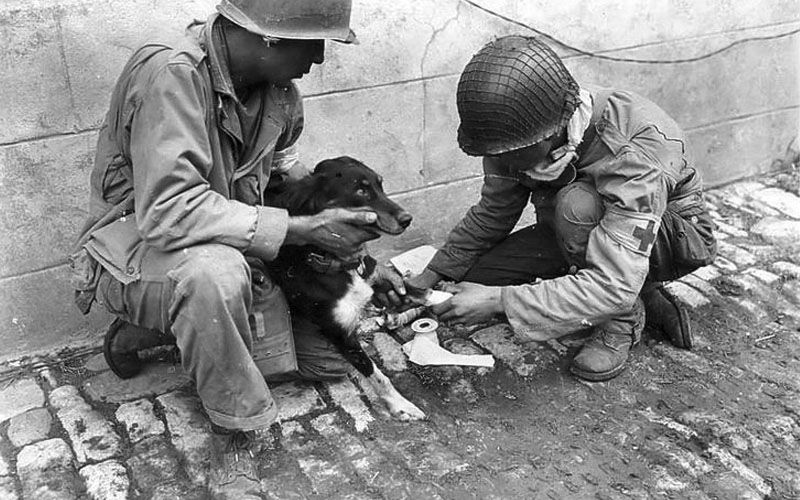
Bing (Brian), was an Alsatian-Collie mix and was awarded the Dickin Medal in March 1947 for services to the 13th Battalion, 6th Airborne Division. Bing was one of a group of dogs known as “Paradogs” and was trained thoroughly for his deployment learning how to identify minefields. He joined the army in 1944 and began his basic training at the Army War Dog Training School near Potters Bar, Hertfordshire. Having qualified as a patrol dog, he was posted to the Recce Platoon, 13th Parachute Battalion where he completed his parachute training.
The 13th Parachute Battalion of the British Army came up with the adventurous experiment of parachuting dogs. These dogs were trained to perform tasks such as locating mines and keeping a watchful eye for the enemy. They also helped with morale becoming mascots for the regiment.
On the eve of the Normandy invasion, three planes carrying the members of 13th Battalion took off for France. In addition to the 60 men aboard, each plane carried one dog. On 6 June, Bing parachuted into France with his handler and trainer Ken Bailey. Bing was later wounded in action and after returning from Normandy he recuperated at the Vet Kennels at Chillbolton Downs near Stockport.
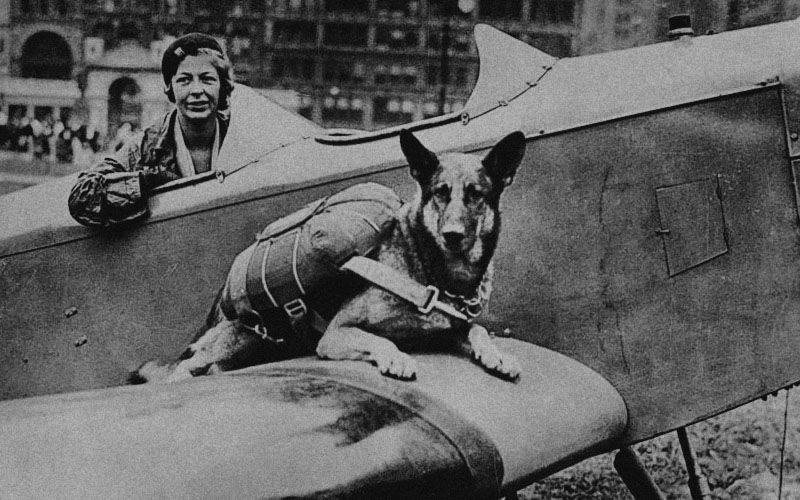
At the end of the war, Bing was demobbed from the army and returned to live with his original owner – Betty Fetch. On 26 April 1947, he received the Dickin Medal during a ceremony at the PDSA Headquarters. His citation reads “This patrol dog was attached to a Parachute Battalion of the 13th Batt. Airborne Division. He landed in Normandy with them and, having done the requisite number of jumps, became a fully-qualified Paratrooper.”
On 26 October 1955, Bing passed away, aged 13 years old, and was buried at the PDSA Animal Cemetery in Ilford, Essex. A model of Bing, complete with parachute, is on display at the Airborne Assault Museum at IWM Duxford.
Lin Wang, an adult male Asian elephant, was not a typical World War Two veteran. He fought on both the Japanese and Chinese sides.
Elephants were used by the Japanese army to transport supplies and pull artillery pieces. Following a battle between the Japanese forces and Chiang Kai-shek’s Chinese Expeditionary Force in 1943, Lin Wang (at the time named “Ah Mei”, meaning “The Beautiful”) was captured by the Chinese. When the Expeditionary Force was recalled to China in 1945 the elephants and their handlers marched back through the Burma Road. Six elephants died during the difficult journey, and by the time they arrived in Guangdong the war was over.
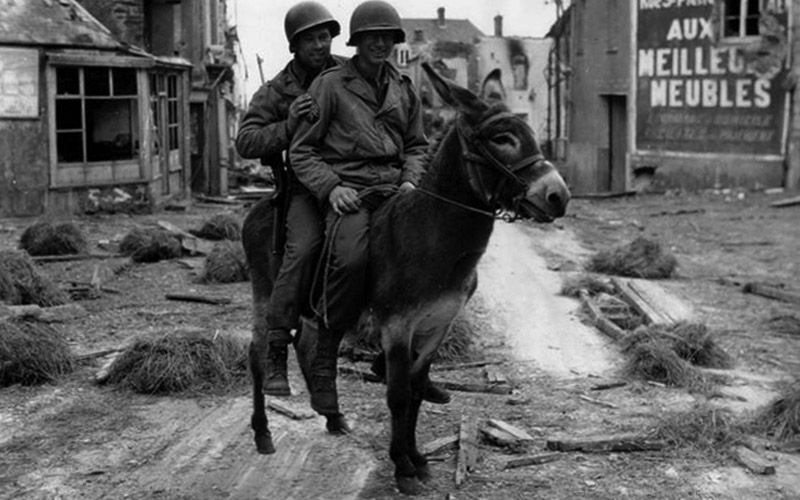
However, the elephants’ service with the army was not over. They participated in building monuments and in the spring of 1946, they also performed for a circus to raise money for famine relief in Hunan province. Later, four elephants from the group were sent to the zoos of Beijing, Shanghai, Nanjing and Changsha. The remaining three elephants, including Lin Wang, were relocated to a park in Guangzhou.
The average life expectancy of a typical Asian elephant at the time was 70 years. Lin Wang lived much longer and died at the age of 86, becoming the longest-living elephant in captivity, surpassing an Indian Elephant who reached the age of 84 before she died in 1997.
In addition to his service to the army, Lin Wang also became a cultural icon and in 2004 he was immortalised in a life-size statue at Taipei Zoo.
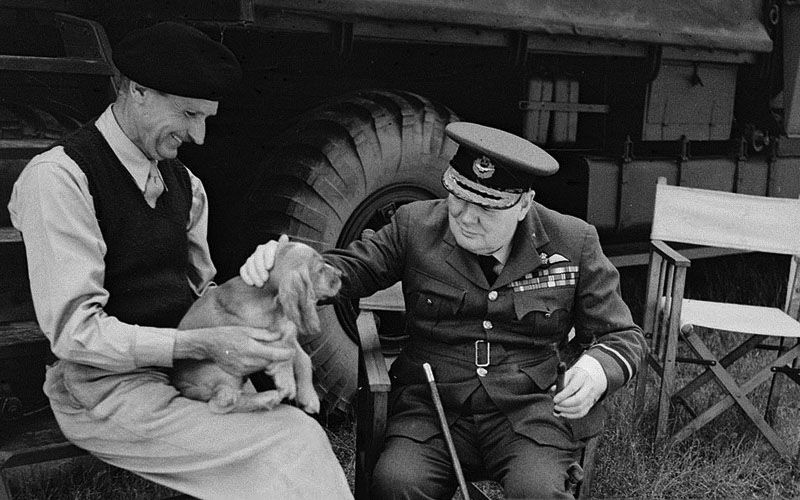
King Neptune, was a pig auctioned in Illinois to raise money for war bonds for the battleship USS Illinois which was at the time under construction. He was obtained by Navy recruiter Don C. Lingle who toured the State with Neptune. The individual parts of the pig were auctioned; his squeal was auctioned for $25 on at least one occasion. High demand for appearances by Neptune led them to travel the rest of Illinois raising funds. Mostly red but with some white features, the Hereford pig was often displayed covered with a blue Navy blanket and wearing a crown and silver earrings.
On March 6, 1943, Illinois Governor Dwight H. Green purchased King Neptune for $1 million on behalf of the state of Illinois. At the same auction, one of Neptune’s bristles was sold for $500. On one occasion in early 1945, a cheque was written to King Neptune for his upkeep. The bank asked Lingle to obtain the pig’s endorsement to cash the cheques. Don C. Lingle was promoted to Chief Petty Officer as a result of his fund-raising efforts with Neptune.
Over the course of King Neptune’s fundraising career, he, Lingle and the auctioneer L. Oard Sitter helped raise $19 million in war bonds, which would be around $200 million today. When he died of pneumonia in 1950 Neptune was given a military funeral.
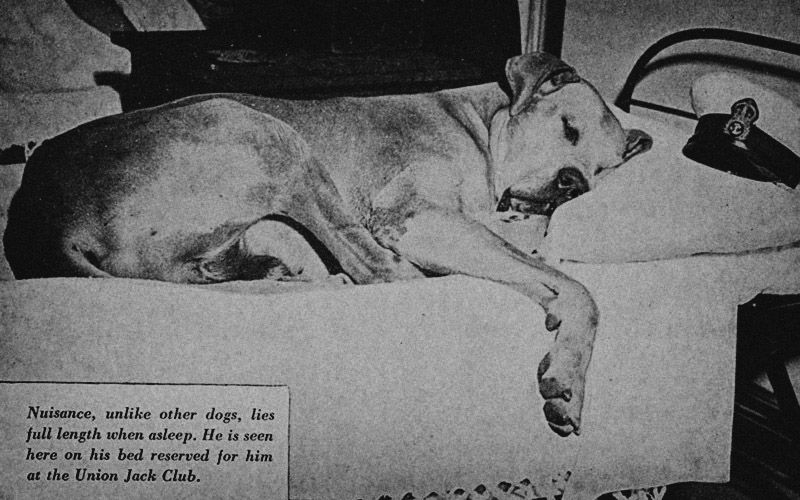
Just Nuisance, was a Great Dane and the only dog ever to be officially enlisted in the Royal Navy. Between 1939 and 1944 he served at HMS Afrikander, a Royal Navy shore establishment in Simon’s Town, South Africa. He died in 1944 at the age of seven years and was buried with full military honours.
He was enlisted on 25 August 1939. His surname was entered as “Nuisance” and, rather than leaving the forename blank, he was given the moniker “Just”. His trade was listed as “Bonecrusher” and his religious affiliation as “Scrounger”, although this was later altered to the more charitable “Canine Divinity League (Anti-Vivisection)”. To allow him to receive rations and because of his longstanding unofficial service, he was promoted from Ordinary Seaman to Able Seaman.
He never went to sea but fulfilled a number of roles ashore. He accompanied sailors on train journeys and escorted them back to base when the pubs closed. While many of his functions were of his own choosing he also appeared at many promotional events including his own ‘wedding’ to another Great Dane, Adinda. Adinda produced five pups as a result. Two of the puppies, named Victor and Wilhelmina, were auctioned off in Cape Town to raise funds for the war effort.
Nuisance’s service record was not exemplary. Aside from the offences of travelling on trains without a pass, being absent without leave, losing his collar and refusing to leave the pub at closing time, his record shows that he was sentenced to having all bones removed for seven days for sleeping in an improper place, namely the bed of one of the Petty Officers. He also fought with dogs from ships that docked at Simon’s Town, resulting in the deaths of at least two of them.
Nuisance was involved in a car accident which caused thrombosis and gradually paralysed him. On 1st January 1944 he was discharged from the Navy. His condition continued to deteriorate and on 1st April 1944 he was taken to Simon’s Town Naval Hospital where, on the advice of the naval veterinary surgeon, he was put to sleep. The next day he was taken to Klawer Camp, where his body was draped with a Royal Naval White Ensign and he was buried with full naval honours, including a gun salute and the playing of the Last Post. A simple granite headstone marks his grave which is on the top of the hill at Klawer, at the former South African Navy Signal School.
A statue was erected in Jubilee Square in Simon’s Town to commemorate his life. The Simon’s Town Museum has an exhibition dedicated to his story and since 2000 there has been an annual parade of Great Danes from which a lookalike is selected.
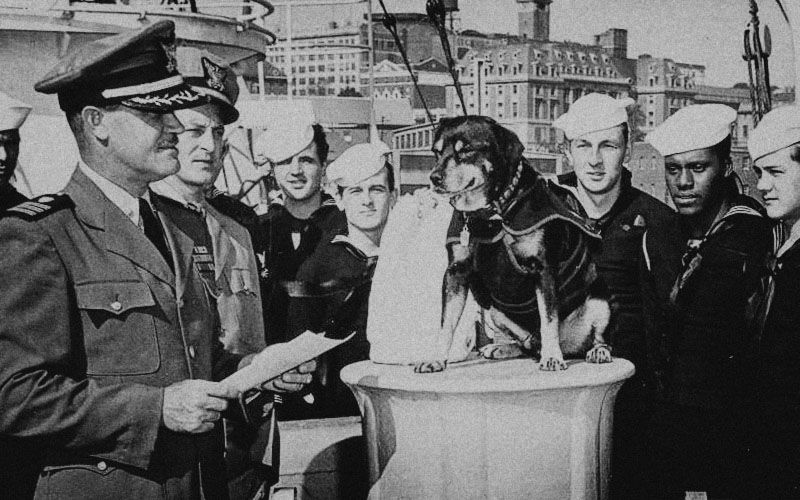
Sinbad was a mixed-breed puppy who was adopted by the crew of US Coast Guard Cutter “Campbell” in 1938. The USCGC Campbell served throughout the Second World War assigned to convoy escort duty in the Atlantic. Although publicity photos depicted Sinbad standing helmeted on the barrel of a large gun, he actually stayed below decks assigned to damage control, keeping him away from the sound of gunfire.
The Campbell’s most significant action involved combat with, and sinking by ramming of, the German submarine U-606. As a result, the cutter suffered severe damage and was without power due to flooding. Essential crew were left aboard the otherwise abandoned ship to keep it afloat as it was towed to Canada for repair, and Sinbad travelled with them. Crew members later stated to the media that Captain James Hirschfield believed that nothing could befall the ship if the dog remained aboard. A statue of Sinbad is on the mess deck of the current “Famous-class” medium endurance cutter USCGC Campbell (WMEC-909).
Sinbad was aboard during other anti-submarine warfare and strafing attacks by enemy aircraft. While less decorated than the ship he called home, Sinbad was awarded the following service ribbons: American Defense Service Medal; American Campaign Medal; European-African-Middle Eastern Campaign Medal; Asiatic-Pacific Campaign Medal; World War II Victory Medal and Navy Occupation Service Medal. These were all attached to Sinbad’s collar.
Sinbad stood watches with the crew, ate in their mess and slept in their mess and their bunks, always choosing a different bunk mate each night. He deliberately avoided the officer’s quarters and only on rare occasions would he associate with officers when on liberty. Every time the Campbell would make port and liberty was granted, he would be first off and along with his shipmates hit the bars.
Sinbad served faithfully for eleven years before retiring to the Barnegat Light Station in New Jersey. He died in 1951 and is buried beneath the station’s flagstaff.
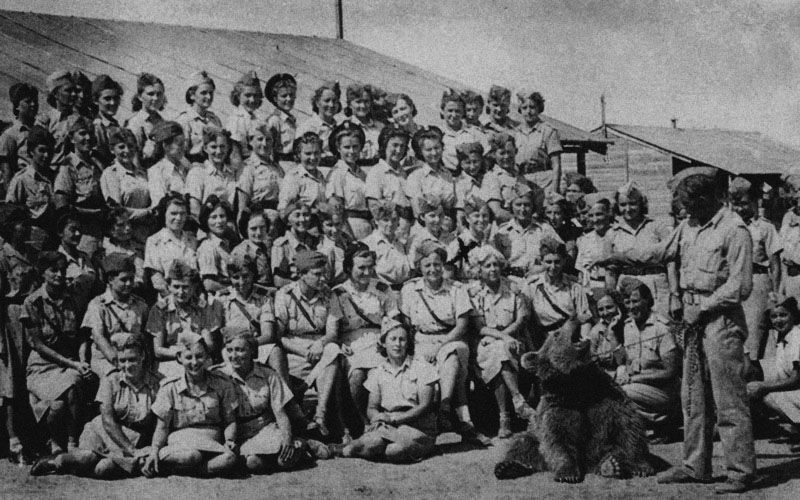
Wojtek was a Syrian Brown Bear who stood 6ft tall and weighed 35 stone. Wotjek, which means “He Who Enjoys War” or “Smiling Warrior” was an orphaned cub adopted by the artillery supply command of the Polish 2nd Corps.
As the unit prepared to enter the war zone in Italy during 1943, the problem confronting the Polish soldiers was the question of Wojtek’s status. Animals were not permitted to accompany the army during fighting, so Wotjek was given his own pay book, rank and serial number. The Polish 2nd Corp soon prepared to break through the German defences at Monte Cassino where it successfully captured the stronghold after much bitter fighting. After the battle, the official badge of the 22nd Transport Company became a likeness of Wojtek holding a shell. This symbol appeared on vehicles, pennants and on the uniforms of the soldiers.
Following the end of the war some Polish soldiers were sent across Europe to Berwick-Upon-Tweed in England where they stayed at Winfield Camp. As the soldiers were demobilised they were forced to say goodbye to Wojtek. However, he found a home at Edinburgh Zoo where he became a popular attraction with many visitors including former Polish servicemen who would talk to him in their native tongue. He died in 1963.
Animals continue to play a significant role with the military and emergency services through the World, whether detecting narcotics, searching for explosives or locating survivors. As well as providing vital assistance to their handlers they can also offer companionship and help boost morale.
Even civilian dogs have been awarded the Dickin Medal. In 2001, two Labrador guide-dogs named Sally and Roselle guided their blind owners to safety down more than 70 flights of stairs inside the damaged World Trade Center building in New York following the September 11th attacks. They received their medals in March 2002.
Recipients of the Dickin Medal
- White Vision, Pigeon (1943)
- Winkie, Pigeon (1943)
- Tyke, Pigeon (1943)
- Bob, Dog (1944)
- Beachcomber, Pigeon (1944)
- Gustav, Pigeon (1944)
- Paddy, Pigeon (1944)
- Rip, Dog (1945)
- Jet, Dog (1945)
- Irma, Dog (1945)
- Beauty, Dog(1945)
- Rob, Dog (1945)
- Kenley Lass, Pigeon (1945)
- Navy Blue, Pigeon (1945)
- Flying Dutchman, Pigeon (1945)
- Dutch Coast, Pigeon (1945)
- Commando, Pigeon (1945)
- Royal Blue, Pigeon (1945)
- Thorn, Dog (1945)
- Rifleman Khan, Dog (1945)
- Rex, Dog (1945)
- Ruhr Express, Pigeon (1945)
- William of Orange, Pigeon (1945)
- Scotch Lass, Pigeon (1945)
- Sheila, Dog (1945)
- Billy, Pigeon (1945)
- Broad Arrow, Pigeon (1945)
- NPS.42.NS.2780, Pigeon (1945)
- NPS.42.NS.7524, Pigeon (1945)
- Maquis, Pigeon (1945)
- Mary of Exeter, Pigeon (1945)
- Peter, Dog (1945)
- Tommy, Pigeon (1946)
- All Alone, Pigeon (1946)
- Judy, Dog (1946)
- Princess, Pigeon (1946)
- Mercury, Pigeon (1946)
- NURP.38.BPC.6, Pigeon (1946)
- G.I. Joe, Pigeon (1946)
- Punch and Judy, Dogs (1946)
- Cologne, Pigeon (1947)
- Duke of Normandy, Pigeon (1947)
- NURP.43.CC.1418, Pigeon (1947)
- DD.43.T.139, Pigeon (1947)
- DD.43.Q.879, Pigeon (1947)
- Ricky, Dog (1947)
- Bing (Brian), Dog (1947)
- Olga, Horse (1947)
- Upstart, Horse (1947)
- Regal, Horse (1947)
- Simon, Cat (1949)
- Antis, Dog (1949)
- Tich, Dog (1949)
- Gander, Dog (2000)
- Appollo, Dog (2002)
- Sally and Roselle, Dogs (2002)
- Sam, Dog (2003)
- Buster, Dog (2003)
- Lucky, Dog (2007)
- Sadie, Dog (2007)
- Treo, Dog (2010)
- Theo, Dog (2012)
- Sasha, Dog (2014)
- Warrior, Horse (2014)
- Diesel, Dog (2015)
- Lucca, Dog (2016)
- Reckless, Horse (2016)
- Mali, Dog (2017)

